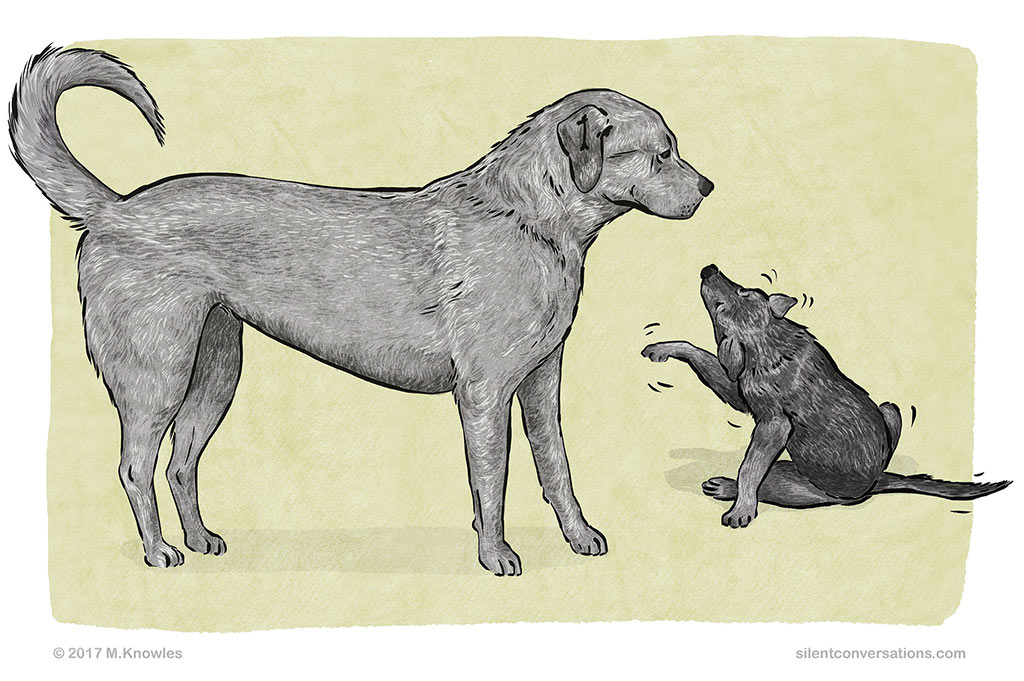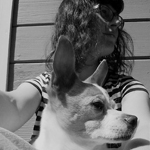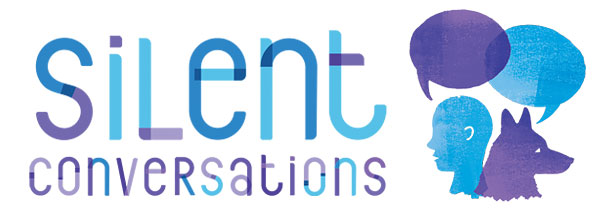
Freezing or Stillness – Dog Body Language
Freezing or stillness in dog body language terms is a very clear signal that speaks loudly. Often it can go unnoticed due to the length of time a freeze may occur, for instance a matter of seconds, or to the untrained eye it may look as if nothing is occurring, so it is not recognized. If a dog is feeling the need to freeze or be still, it means that they are experiencing a high level of unease. In some instances when a dog is still, the situation may not escalate further; the freeze may mean the dog is so uncomfortable/stressed* with the situation that he feels he has no option but to shut down. In other situations, depending on the full body language observed and context, freezing may be part of a warning, and the situation is quite likely to escalate. There may or may not be further body language signals, with there being a good chance of the situation escalating towards a bite.
Freezing (which is listed as ‘Stiffening up, stare’) is placed quite high up on the ‘The Canine Ladder of Aggression‘ by Kendal Shepherd. The Canine Ladder of Aggression is an illustrated escalation list of body language signals that could be displayed as the dog reacts to stress or perceived threat. The dog may show some of the signals lower on the ladder, such as lip licks or yawning, to communicate discomfort and as an attempt to peacefully resolve the situation. The ladder is only a guide; some steps may be omitted, and the dog may move up the steps more quickly, depending on the context and the dog’s previous experiences.
Freezing should always be respected, taken seriously, and treated with caution. Even if it does not escalate to a bite, it is a very clear loud signal that the dog is not comfortable and needs more space.
Here are a couple of examples of situations where a dog may offer a freeze:
-
A dog is hugged by a person. The dog does a lip lick, her eyes appear large, her ears are back, and her mouth is closed. She turns her head away and freezes as the person continues to hug her. As soon as the person lets go, she walks away and does a shake off. The dog is showing that she is not comfortable with the interaction. Luckily, in this case, this does not escalate to a bite, even though the calming signals have been ignored. Freezing, along with the other body language signals, should be paid attention to, as even a really friendly dog can be pushed if her communication is continually ignored. There may be times that calming signals are not displayed and only a freeze is seen, as mentioned in ‘How do you greet a dog politely?’
-
Here is an observation of a dog that is quite fearful in a new shelter environment: When a person walks into the dog’s room, it does not approach the person but keeps at a distance, staying on its bed. The dog’s ears are back, eyes are wide, and pupils dilated. Her body is stiff, lowered and crouched. Her mouth is closed, and there is tension in the mouth as well as furrows on her brow and other areas of the face. She avoids direct eye contact by turning her head slightly or by slight movement of the eyes to the side, but she does not feel safe enough to take her eyes off the person in the room. This calming signal of trying to avoid eye contact whilst still trying to keep an eye on the person, means the whites or sclera of the eye are visible. This is called whale eye. The dog also seems frozen in place. With this observed body language, I would keep my distance, as this dog is experiencing a high state of stress and fear. If cornered with no escape, it is highly likely she would feel no option but to bite to defend herself.
-
This is an observation from a video, showing an interaction between a dog and toddler, who does get bitten by the dog. The whole interaction takes 19 seconds, and a great deal of subtle body language occurs during that short space of time to show the dog is uncomfortable. The toddler is crawling on the ground, playing with the dog’s tail. The dog lies on the floor, positioned in a corner without escape. When the toddler starts pulling at his tail, the dog turns his head away. His mouth is closed, tension is seen in the face and eye areas, his ears are to the side, and he keeps still, in this position for a while. The toddler continues to pull at the tail. The dog then turns his head in the other direction, still facing away, this time with his head slightly lifted, mouth still closed, eyes wide, and ears to the side. Now, the dog is even stiller and in a frozen position. The toddler gives one more yank on the tail, and the dog lashes out after his subtle body language warnings have been ignored. This unfortunate situation should have been managed so that neither child nor dog was placed in such a position.
For resources to learn more on ways to provide safe supervision and management of children and dogs go to www.familypaws.com
-
An older dog is playing with a toy and a younger dog is circling her. The older dog would rather play with the toy on her own. The younger dog keeps jumping around in front of the older dog, doing play bows (this is when the paws go down on the ground and the dog’s rear end is in the air), and he barks at her. The older dog’s ears are to the side; she closes her mouth, freezes, and gives direct eye contact. This is a direct warning to the pup to leave her alone and give her space. If the young pup continues pestering her, it is likely the older dog may growl or snap at the pup after this firm warning. People normally react to the fracas involving their dogs a few seconds later and miss the short freeze and stare before the situation escalates.
-
A dog is eating out of his food bowl. As someone passes by, he keeps his head down over his bowl; the dog freezes, his ears are to the side, his tail tucked away, and his body looks very stiff. The dog is feeling uncomfortable and feels some perceived threat. The person should not move closer as that will escalate the situation.
These are just a few examples; there may be many more. Start observing to see if you can notice any freezing or stillness in different contexts. As discussed below, interpretations such as the above examples should not be attempted without careful observation and consideration of all aspects of the situation.
What is meant by stress*?
When I mention stress, this does not necessarily imply negative emotion. I mean stress in the physiological sense. So certain body language signals can mean the dog is feeling some sort of emotional discourse. This discourse could range from positive to negative emotion. Both excitement and fear could have similar effects on the body, with various hormones being released and activating the sympathetic nervous system. The dog may be feeling uncomfortable/fearful or it could also be excited about something. When analyzing stress in body language, it is worth noting the frequency and intensity of the various body language signals. Although in this scenario, when a dog feels the need to display stillness or freezing, the dog is feeling a high level of discomfort and threat.
A few notes to consider when observing dog body language
Observation before interpretation
Interpretations should be offered only once you have observed the complete interaction and taken note of the wider picture. To offer an unbiased interpretation of the body language, observe and take note of the situation, taking into account the dog’s whole body, the body language signals, and environment first before offering an interpretation. List all the body language you see in the order that it occurs; try to be as descriptive as possible without adding any emotional language. For instance, saying a dog looks happy is not descriptive and would be seen as an interpretation rather than an observation.
You could, however, list what you observe: ears to the side, eyes almond shaped, slight shortening of the eye, mouth open, long lips, tongue out, body moving loosely, body facing side on, tail wagging at slow even pace at body level.
From the observation, I could interpret that the dog seems relaxed or comfortable. I still prefer to say relaxed rather than happy, as I feel you will truly never know exactly what the dog may be feeling on the inside emotionally. It is quite likely the dog may be feeling happy, but I prefer to comment on how the dog is behaving in response to the situation rather than presuming internal emotional states.
The importance of viewing body language within context
Interpretations can vary depending on the context. It is possible for certain body language to be used in different contexts and have subtle differences in meaning within those contexts. Individual body language signals should not be observed in isolation; the wider picture should be considered. Take note of what the dog’s body as a whole is saying. Keep in mind each dog is an individual with varying skills and experiences. What may be typical for one individual may not be for another. In order to observe body language in context, consider the following: the situation, body language signals, the body language expressed by all parts of the dog’s body, environment, and individuals involved. It is worth noting how the body language changes with feedback from the environment or the other individuals interacting.
Download a copy of ‘The Canine Ladder of Aggression’ here from Kendal Shepherd’s website.

Martha Knowles
Author
My vision is to create a community of dog guardians who share their observations and interpretations of their dogs’ silent conversations. Hopefully, these experiences and stories will provide some insight into dog communication, which is often overlooked by the untrained eye because it is unfamiliar to humans. We are accustomed to communicating mainly with sound, so we are not attuned to the silent subtle gestures and body language used by dogs to communicate. If you take the time to observe, you will start to see these 'silent conversations' going on around you. My dream is for dog communication to become common knowledge with all dog guardians and as many people as possible. Surprisingly, there are still some professionals working in various dog-related careers who are uneducated about dog body language. Greater awareness of how dogs communicate will help to provide better understanding and improve the mutual relationship between dogs and humans. This will promote safer interactions between our two species and hopefully remove some of the expectations placed on dogs within human society. I would like dog guardians to feel empowered with their knowledge of dog communication so that they can be their dogs’ advocates and stand up for themselves and their dogs when it really matters.
